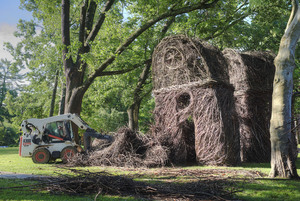

Patrick Dougherty, a sculptor based in Chapel Hill, N.C., has been conceiving and constructing monumental and fanciful site-specific structures, indoors and outdoors, around the world for more than 30 years. His "stickwork" has been seen in France, Australia, South Korea, Hungary, Scotland, Italy and scores of locations throughout the United States.
JOHNSON CITY – In November 2013, it took about 125 community and campus volunteers – under the guidance of environmental artist Patrick Dougherty – three weeks to harvest local saplings and weave together the four "chapelets" of "That Old-Time Religion" under the trees near the carillon at East Tennessee State University.
In May, members of the ETSU grounds crew dismantled the "stick sculpture."
"Unfortunately, Patrick's work is ephemeral, and we knew it would need to come down when we commissioned him," says Anita DeAngelis, director of Mary B. Martin School of the Arts at ETSU. "As the sticks dry, they become brittle, and the work had started to look a bit shabby. Once it reaches that point, Patrick wants the work to come down.
"His work is usually up for two years, and we've had this one just over three-and-a-half years. It's been wonderful to have this sculpture on the ETSU campus, and we'll really miss it. But we have some ideas for a new project to put in the same location."
Dougherty, a sculptor based in Chapel Hill, North Carolina, has been conceiving and constructing monumental and fanciful site-specific structures, indoors and outdoors, around the world for more than 30 years. His "stickwork" has been seen in France, Australia, South Korea, Hungary, Scotland, Italy and scores of locations throughout the United States – more than 250 sites to date.
"There's a way that you look at this work and care about it and care for it, knowing it's not going to exist (forever) because you know what's going to happen to sticks," Dougherty said in a recent "CBS Sunday Morning" interview. "You see a stick and you kind of know that it's like a leaf. It's going to break down. Something's going to happen to it. It's going to blow away.
"In a sense, the most powerful part of it is that it's not lasting. We all recognize that we have a limited life span ourselves."
For more information on Dougherty's work, visit http://www.stickwork.net. For more about Mary B. Martin School of the Arts, visit www.etsu.edu/martin.